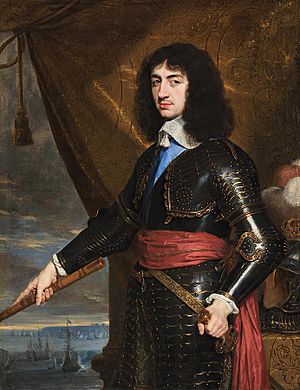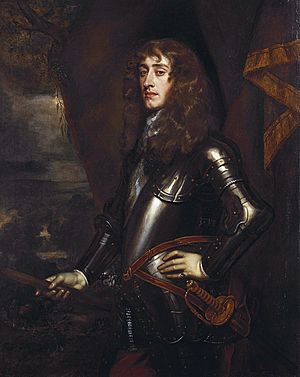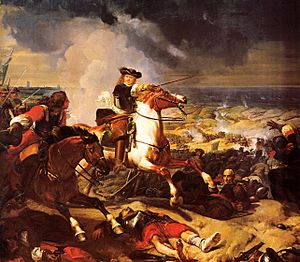Royalist Army in Exile facts for kids

The Royalist Army in Exile was an army created by supporters of King Charles II. This happened between 1656 and 1660, while Charles was living outside England. The army was made up of different groups. It included Royalist soldiers from England and Scotland. But most of the soldiers were Catholics from Ireland. Many of these Irish soldiers had fought in earlier wars in Ireland.
Why the Army Was Formed
Charles II had been living in France. He went there after losing the Battle of Worcester. But France later made a deal with Oliver Cromwell, who ruled England at the time. This deal forced Charles to leave France.
So, Charles signed a new agreement with Spain in 1656. In this deal, he promised to raise an army to help Spain fight France. Many Royalists who had lost the English Civil War were already living in Europe. Also, many Irish soldiers had become mercenaries (soldiers who fight for money) after Cromwell conquered Ireland. Some Irish regiments were even serving in the French army. Charles's younger brother, James, Duke of York, was also serving in the French army.
Who Joined the Army?

Charles II had promised Spain that he would recruit Irish soldiers from the French armies. Some soldiers started leaving the French army in small groups to join Charles. Charles's main advisors, Edward Hyde and Lord Ormonde, talked to the leaders of these Irish regiments. Many of these leaders had fought for Charles before.
Even though France tried to stop them, all the Irish colonels eventually switched to serve King Charles. If their commanders didn't let them go, many soldiers simply left the French army and went to the Spanish Netherlands (part of modern-day Belgium and Netherlands). However, some Irish soldiers chose to stay with the French. Because of this, the Royalists also recruited new soldiers directly from Ireland.
James, Duke of York, was at first unwilling to leave his position in the French army. He thought it helped the Royalist cause more. But he joined his brother's army after Charles gave him a direct order.
English Royalists, called Cavaliers, also joined. They formed an infantry regiment (a group of foot soldiers). This group was led by Lord Rochester. This regiment later became the famous Grenadier Guards. A separate Scottish infantry regiment was also formed. It included experienced soldiers from earlier Scottish uprisings.
The Irish troops were put into different regiments. These were officially led by exiled princes, but their old colonels were in charge day-to-day. For example, Ormonde's Regiment was led by Richard Grace. The Duke of York's Regiment was led by Lord Muskerry. The Duke of Gloucester's Regiment was led by Lord Taaffe. A fourth Irish regiment was formed under Lisagh Farrell. He brought his regiment over from a French base near Brussels. This regiment was formally under Lord Bristol, who helped them switch sides.
Besides these six infantry regiments, a small group of horsemen (cavalry) was formed. They served with the Duke of York. There were plans for a larger cavalry regiment, but it never happened. A younger officer named Richard Talbot, who would later become important, also served with the Duke of York.
Fighting the War

The Royalist Army got supplies and weapons from their Spanish allies. In return, they promised to try and capture a port in England. They hoped this would start a rebellion against Oliver Cromwell's government. Cromwell's spymaster, John Thurloe, had agents who watched the exile army very closely.
In 1658, a combined force of Cromwell's English soldiers and French troops attacked Dunkirk. The Spanish and their English Royalist allies met them at the Battle of the Dunes. Charles's army and their allies were badly defeated. Dunkirk fell to the French and English soon after.
The Royalist army continued to fight with the Spanish armies. This lasted until a peace treaty, the Treaty of the Pyrenees, ended the war in November 1659. By that time, things were changing in Britain after Oliver Cromwell's death. These changes led to Charles II becoming king again the next year. This event is known as the Restoration.
What Happened Next?
After Charles II became king, England decided it needed a much smaller army. The large New Model Army was disbanded. New laws, called penal laws, stopped Catholics from serving in the new English Army or the Irish army.
Many soldiers from the exiled Royalist Army stayed in Dunkirk. They were there until the city was sold to the French in 1662. They even served alongside some of their old enemies from the Battle of the Dunes. After that, these soldiers were sent to different places. Some went to serve in the Tangier Garrison in Morocco. Others joined the English expedition to Portugal.

